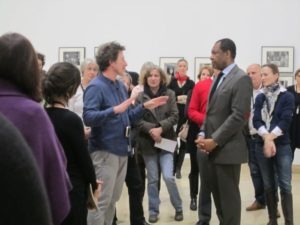
documenta diaries iii: neue neue galerie

Arin Rungjang, 246247596248914102516 … And then there were none (2017). Video still.
The German friend I went with said aloud what I was thinking: “Whoever at Documenta decided to call this the ‘Neue Neue Galerie’…just…shouldn’t…ever…” accompanied by a grim sächsische head-shake. Restyling the already-interesting and well-known Brutalist Neue Post building in this way is so typical of Documenta 14: It’s that Mentos-commercial “humor” that isn’t funny and also isn’t nostalgic, ironic, kitschy, or whatever else might have settled the account with the “marketing team.” Nonetheless despite being afflicted by branding and the continuing curatorial confusion that has muddled much of Documenta 14, some of the art inside the former mail-sorting center ascends on its own merits.
The most interesting, and centrally important to Kassel, entries in all of Documenta is the project by the Society of Friends of Halit, a group of artists and researchers who apply pressure to the investigation into the 2006 murder of 21-year-old Halit Yozgat. Yozgat was shot to death in the Internet café his family ran on Höllandischestraße, just around the corner from the Neue Post, the ninth in a string of Neo-Nazi hate crimes. Hessian undercover detective Andreas Temme was in the café yet claims to have seen and heard nothing. With 77sqm_9:26min (2017), the Society reveals their findings – reconstructed through forensic architectural, olfactory projection (!), and sound renderings; interviews with passersby, and film clips of testimony and evidence. Finally an example of the ability of art to change and influence events in the world, and even render justice.

Arin Rungjang (geb. 1974, Bangkok) 246247596248914102516 … And then there were none (2017) Digitalvideo, Farbe, Ton; Holz- und Blechplastik; 2 Malereien und 2 Arbeiten auf Papier Video: 30 min
Perhaps the lone Documenta installation aspiring to Gesamtkunstwerk is Arin Rungjang’s 246247596248914102516… And then there were none (Democracy Monument) (2017). The installation is composed of a wood and brass panel-frieze, sculpture, photographic portraits, video installation, paintings, drawings, and books. The video itself includes an original modern dance performance about World War II historic sites in Berlin and Munich, the manufacture of the frieze, and an attendant controversy in Thailand, and – rare for Documenta Kassel – an acknowledgment of the fair’s earlier iteration in Athens. 246247596248914102516 is a reach that might not have worked, but Rungjang’s combination of precision and sincerity is peerless.
(more…)
